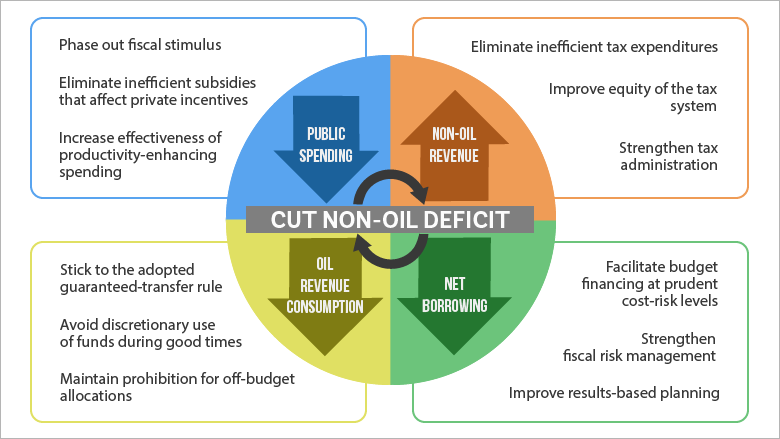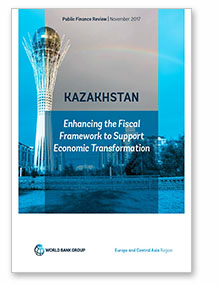Kazakhstan benefited greatly from the oil boom of 2000–14, which led to income growth and poverty reduction and helped build a fiscal cushion to stabilize the economy during downturns. During the same period, nominal GDP per capita increased ten-fold, from US$ 1,229 in 2000 to US$ 12,807 in 2014, mainly due to price effects from currency appreciation that followed an expansion of the oil sector.
Income growth led to a substantial decline in the poverty rate, from 77% in 2001 to 16% in 2014.
As oil output more than doubled and the oil price super-cycle emerged, the Government of Kazakhstan accumulated substantial fiscal savings in its oil fund, the National Fund of the Republic of Kazakhstan (NFRK). Fiscal savings in the NFRK peaked at US$ 73 billion (33% of GDP) at the end of 2014. A portion of these funds was used for anti-crisis programs in 2007–10, during which time the fiscal stimulus program totaled US$ 18 billion (about 15% of GDP).
The oil-price shock since mid-2014 is a structural shift to a "new normal" that requires structural rather than countercyclical fiscal measures. Unlike a temporary crisis that can be managed by a countercyclical response to restore macroeconomic stability, this structural shift—to a new, low oil-price environment—may persist for many years.
As such, an overuse of macro-fiscal stimulus measures is likely to be both ineffective and expensive. An attempt to defend a peg of the Kazakhstan tenge to the U.S. dollar required the authorities to inject more than US$ 30 billion in foreign-currency interventions in 2014–15, while the current fiscal stimulus package already exceeded US$ 20 billion (12% of GDP) in 2014–17.
As a result, the NFRK balance has fallen from US$ 73 billion in 2014 to a projected US$ 53 billion by the end of 2017. The authorities moved to a floating exchange rate regime in the second half of 2015 to stop the leakage of foreign exchange reserves. However, an accompanying fiscal adjustment has not materialized. Some policy makers may still believe that the shock is cyclical and maintain hope that oil prices will recover.
However, the authorities must urgently adopt and start implementing a fiscal consolidation strategy and refocus macro-fiscal policy on promoting diversified growth and high-quality job creation.
The countercyclical fiscal stance adopted in 2014 led to an increase in the non-oil fiscal deficit, which is too high to ensure medium-term fiscal sustainability and threatens the long-term growth potential of the non-oil tradable economy.
Successful fiscal consolidation would require two things: reducing inefficient expenditure that distorts private incentives while redirecting savings toward productivity-enhancing spending; and eliminating inefficient tax benefits that result in an uneven playing field for investment.
While pursuing a fiscal consolidation effort over the medium-term, there are potential benefits to reviewing Kazakhstan’s fiscal policy framework and institutions with the goal of strengthening their coherence, credibility, and flexibility.
While developing a fiscal consolidation strategy, the authorities should address four policy areas to enhance fiscal sustainability and support economic transformation. The four policy focus areas are: 1) enhancing the credibility of the fiscal policy framework; 2) improving public spending efficiency and effectiveness; 3) mobilizing nonoil revenue and optimizing the tax system; and 4) strengthening fiscal policy institutions.


